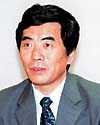 |
 Expectations
for NHK STRL Expectations
for NHK STRL-A view from a member of the Broadcasting Technology Research Committee Fumio Takahata, Chairman, Broadcasting Technology Research Committee (Professor, Waseda University) I look forward, through my participation in the Broadcasting Technology Research Committee, to seeing the many wonderful research and development projects underway at the NHK Science & Technical Research Laboratories (STRL). One of the things that most impresses me is how fully those in the Laboratories that I have met through the Committee are aware of the importance of pursuing research and development that will satisfy viewer needs. Although my specialty is transmission schemes and network configurations in relation to wireless communications, I also have an especially strong interest in signal processing, a technology fundamental to such communications. I look forward to the day when digital-processing technology will seamlessly connect communications and broadcasting. Even though the digitalization of broadcasting in Japan has been somewhat delayed compared with that of wireless communications for cellular phones, satellite broadcasting was digitalized at the end of 2000, and preparation work for the digitalization of terrestrial television broadcasting has been steadily advancing. The realization of completely digital networks, integrating communications and broadcasting, is just around the corner. For me personally, the Committee is the most suitable place to obtain information on the latest advances outside my specialty. In it, many topics are discussed, for example, HDTV, home servers, broadcast-news speech transcription, 3D TV, HARP imaging technology, program retrieval agents, and flat displays including PDPs. There is a widely developing discussion on the "fusion of telecommunication and broadcasting." STRL is one of few research institutions that is promoting research into the "fusion of technology and culture." I expect that STRL will promote the Triune research and development of communications, broadcasting, and culture through the best use of this new environment. At the Committee meeting last June, a heated discussion took place concerning STRL's mid-to long-term vision, by which STRL will advance research based on the three pillars of "advanced ISDB," "contents production technologies," and "future broadcasting services and their fundamental technologies." As the Chairman of the Committee, I will continue to work to draw out the frank opinions of the members, who are experts in a variety of fields, and to facilitate free and active discussions. A new and long-awaited STRL building, equipped with a research environment suitable for the 21st century, will be completed soon. I hope that STRL will continue to develop as an outstanding top-level research institution, known not only in Japan, but also world-wide.
|